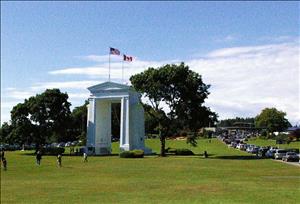On March 30, 1922, France's Marshal Joseph Joffre (1852-1931) rededicates the Peace Arch on the border of the United States and Canada at Blaine. The arch, which straddles the border, had been first dedicated by Samuel Hill (1857-1931) the previous September when it was completed. After its original dedication, the Joffre visit and rededication is the first of hundreds of celebrations and ceremonies that will be held at the Peace Arch in the years to follow.
The Hero of the Marne
Joseph Joffre served as commander of the French Army during the first years of World War I (1914-1918). In the early weeks of the war he achieved considerable fame in the First Battle of the Marne, when troops under his command repulsed an aggressive German attack that threatened Paris and had the potential to knock France out of the war entirely. As a result he earned the nickname "The Hero of the Marne."
In 1921 it was announced that Joffre would visit Canada and the United States, including Seattle, the following year as part of a larger world tour to promote peace. Samuel Hill, the force behind the creation of the newly built Peace Arch and with his own vision of peace, met Joffre in Yokohama, Japan, in January 1922 and joined him as he toured the Far East. They arrived in British Columbia during the last week of March and visited Victoria, Vancouver, and New Westminster, B.C., before arriving at the Peace Arch on March 30.
A Friend of Peace
Joffre’s visit to the Peace Arch generated widespread excitement as far south as Seattle. All of Whatcom County’s five American Legion posts were invited to give a special presentation, and the border town of Blaine was especially excited about the occasion, lining both its streets and the road from the town to the arch with banners and flags. Several thousand people turned out and waited patiently under sunny skies as his scheduled arrival time of 3 p.m. passed with no Joffre. But they cheered when he arrived at 3:15 and stepped grandly through an American Legion guard of honor lining both sides of the Peace Arch portal and onto American soil, where he was greeted by Major Ulysses S. Grant III (1881-1968), grandson of the famed Civil War leader and U.S. president. Grant would serve as Joffre's aide during the rest of his American tour.
The Blaine Juvenile and Bellingham Elks bands struck up France’s national anthem, the "Marseillaise," while French, British, American, and Belgian flags were ceremoniously raised onto each of the four corners of the Peace Arch. Four attractive young women presented Joffre with armloads of tulips, and he joined other dignitaries on a platform on the American side of the arch. Blaine’s mayor, Harold Hunter (1878?-1950), welcomed both Joffre and Hill in a short speech. Hill followed with his own speech, graciously declaring that it was Joffre who had made dedication of the Peace Arch possible. Joffre then gave a brief but enthusiastic speech in French, which was translated at its conclusion by M. Christian Vacher-Corbiere, French counsel in Seattle:
"I came here as a messenger, a friend of peace. I speak as a friend of peace. I am the first one to remember all the ruin and misfortune of war which I have seen with my own eyes. But every nation must be ready to defend its freedom. True peace must come through freedom and equality of nations of the world" (“Freedom Needs Defenders...”).
Only The Beginning
Mrs. Edgar Ames of Seattle followed. Speaking in French, she detailed plans of the Minute Woman Association of Washington to dedicate one of 240 planned sculpted stone monuments along the Western Front in France and Belgium as a memorial the soldiers of World War I. (One hundred eighteen stones were eventually put in place before funding faded away in the late 1920s.) Congratulatory telegrams were read, and Hildur Lindgren of Seattle finished the ceremony by singing the "Marseillaise" while draped in a French flag that had been carried by front-line French troops as they marched through Boulogne on Armistice Day, 1918.
By 5 p.m. the ceremony was over. Joffre and his entourage headed to Bellingham by car and then on to Seattle by private train, while the rest of the happy crowd dispersed. Yet despite their enthusiasm, it would have been hard for anyone there to envision what the Peace Arch would eventually come to be. In 1922 there was no park at the site (and wouldn’t be for a decade), just seven acres of land on both sides of the border with a 67-foot tall concrete arch in the middle. Moreover, the acreage on the Canadian side of the arch still looked as it had in the 1890s, with a less-than-reputable hotel and outbuildings within a stone’s throw of the arch. But the idea behind the Peace Arch lived on, and hundreds of such celebrations and ceremonies -- some commemorating peace, others devoted to Knights of Columbus picnics and international chess matches -- followed.
And so did another dedication. Romania’s Queen Marie visited Blaine in November 1926 to rededicate the Peace Arch, giving it the distinction of having been dedicated three times.

